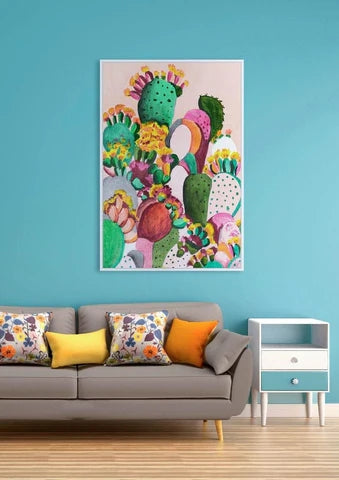
Elevate Your Space: A Comprehensive Guide to Choosing Art for Your Home
Share

Art in Your Home: How to Pick Art That Matches Your Style
Art possesses a profound power to express individuality, transform living spaces, and elevate everyday experiences. Whether you're an avid art collector or a novice in the expansive world of art, finding the right pieces that resonate with your style and enhance your home’s décor can seem daunting. This guide delves into the essentials of selecting art that not only matches your personal aesthetic but also enriches your living environment.
Why Art is Important in Home Décor
Art transcends mere decoration; it influences our emotions, sparks dialogue, and commands attention within any space. It reflects our personalities and styles, adding layers of uniqueness and personal touches to our homes.
Adding Personality to Your Home
Art is an expression of individuality. It can display your passions, interests, and beliefs. For instance, nature enthusiasts might choose landscape paintings that bring the tranquility of the outdoors inside, while music lovers might adorn their walls with vibrant posters of iconic concerts or beloved bands.
Creating a Focal Point
Strategically placed art can serve as a dramatic focal point in any room, guiding the viewer’s eye and harmonizing the space. A bold, large-scale piece can dominate a room magnificently, while an array of smaller pieces can introduce complexity and intrigue through a gallery wall.
Setting the Mood
The choice of art can significantly affect the atmosphere of a room. Vibrant colors can energize a space, while soft hues can soothe it. The subject matter, too, plays a critical role—imagine the tranquility of a soft seascape versus the dynamic energy of an urban skyline.
How to Pick Art That Matches Your Style
Selecting art for your home involves a reflection of your personal taste and a consideration of your home's existing aesthetic.
Consider Your Personal Style
Begin by assessing your own style preferences. Are you drawn to the boldness of modern abstracts, or do you lean towards the intricacy of traditional realism? Understanding your own taste is the first step towards finding art that you will cherish and enjoy over time.
Take Inspiration from Your Home Décor
Let the existing décor of your home guide you. The colours, textures, and style of your furnishings can provide a cohesive framework for selecting art. For homes adorned with natural materials like wood and stone, artworks that echo these elements can enhance the organic feel of the space.
Consider the Room’s Function
The function of a room should influence the art you choose. Calm, serene artworks may be ideal for bedrooms or study areas, while lively, captivating pieces can enhance living areas or kitchens where more activity takes place.
Mix and Match Styles
Don't shy away from mixing different artistic styles. A contemporary home can come alive with a classic piece, adding a layer of surprise and sophistication. Similarly, a rustic styled home could be energized by modern art, creating a dynamic interplay of styles.

Where to Find Art for Your Home
Local Art Galleries and Fairs
Supporting local artists not only helps the local economy but also connects you to unique and original pieces that might not be found anywhere else. Art fairs and local galleries offer a chance to discover emerging talent and acquire art that has a personal connection.
Online Marketplaces
Platforms like Etsy, Artsy, and Society6 provide access to a global selection of art at various price points. These marketplaces allow you to support independent artists and find pieces that speak directly to your personal style.
Thrift Stores and Flea Markets
For those on a budget, thrift stores and flea markets offer the thrill of the hunt and the joy of finding art that is both affordable and unique. You might find a vintage gem or a DIY project that could become a personalised masterpiece.
Create Your Own Art
Creating your own art can be a deeply rewarding way to personalise your space. Whether it’s a simple abstract painting, a sophisticated collage, or a hand-drawn sketch, your own artwork adds an incomparable personal touch to your home.
Tips for Displaying Art in Your Home
Consider the Size and Placement
The impact of art depends significantly on how it is displayed. Consider the scale of the piece in relation to your room and place large works at eye level in key visual points like over a sofa or mantlepiece.
Use Proper Hanging Techniques
Ensure that your art is hung securely. Use appropriate hooks and wires, and consider the wall material when choosing hanging equipment. For heavier pieces, securing the art to studs in the wall can prevent accidents and damage.
Mix and Match Frames
Frames are more than just protective edges; they are an extension of the art itself. Mixing frame styles, colors, and textures can add depth to your display and highlight the artwork within.
Consider Lighting
Art can look dramatically different under various lighting conditions. Consider using adjustable ceiling lights or picture lights to highlight your art and make it a true focal point in your room.
Conclusion
Art enriches living spaces in deeply personal and visually dynamic ways. By selecting pieces that resonate with your personal style and effectively incorporating them into your home, you elevate not just your walls but also your quality of life. Dive into the art world with confidence and curate a space that is truly reflective of who you are. Start exploring today and transform your home into a gallery of personal expression.
![update alt-text with template [product_title]-[product_type]-[product_vendor]-[option1]-[option2]-[option3]-Prime Furniture](http://www.prime-furniture.com.au/cdn/shop/files/New_Prime_logo_-_Rectangle_White__4_-removebg-preview.png?v=1715321544&width=600)

